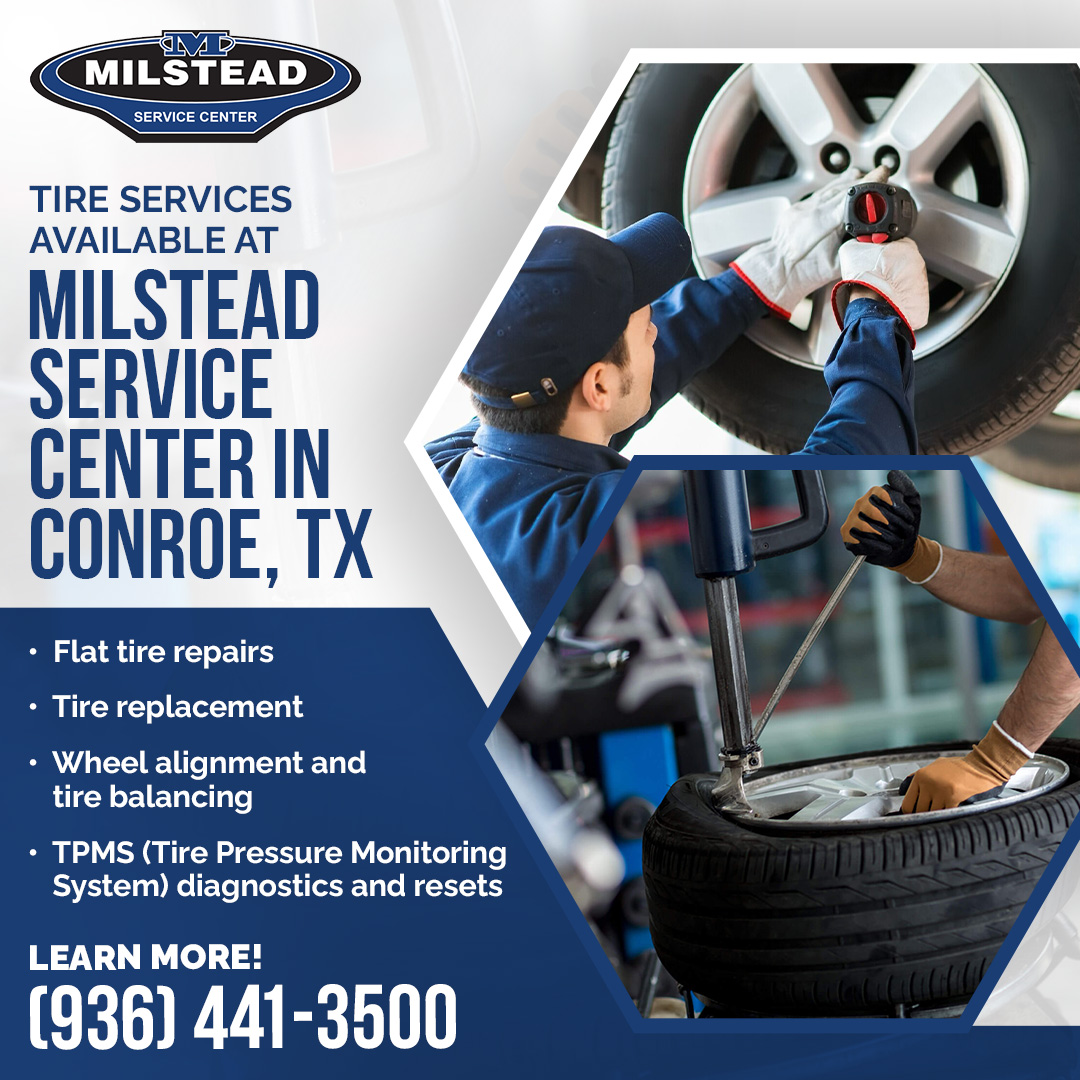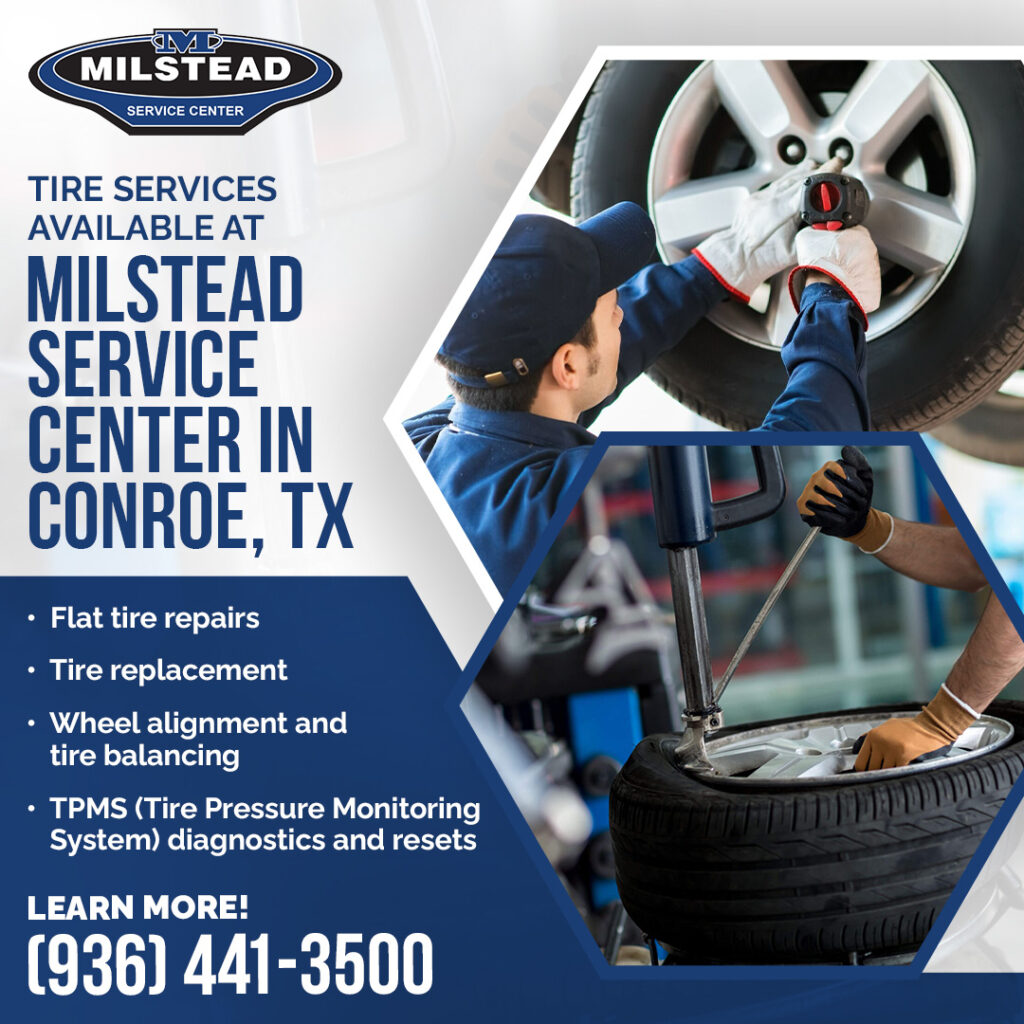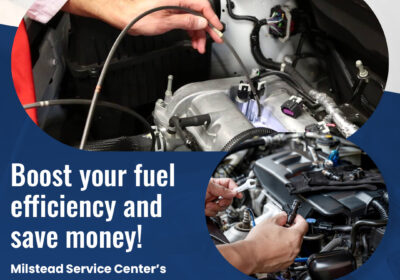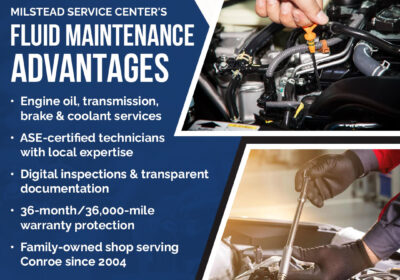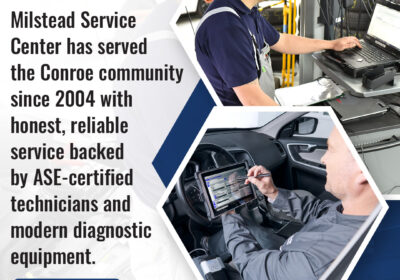A punctured tire can often be repaired, but not in every case. The location, size, and type of damage determine whether repair is safe or replacement is required. Sharp debris, potholes, and curbs can all lead to punctures. While many drivers hope for a simple fix, not all damage can be safely repaired. Auto mechanics follow strict guidelines when deciding between repair and replacement. These guidelines are based on tire structure, road safety standards, and long-term performance. Ignoring them can increase the risk of blowouts or uneven wear.
At Milstead Service Center, our certified auto mechanics provide honest inspections and use industry-accepted methods to help drivers in Conroe, TX, make the right call. Knowing the facts behind tire repair decisions helps drivers avoid repeat issues and save money long-term. Let’s walk through the key factors that determine your options.
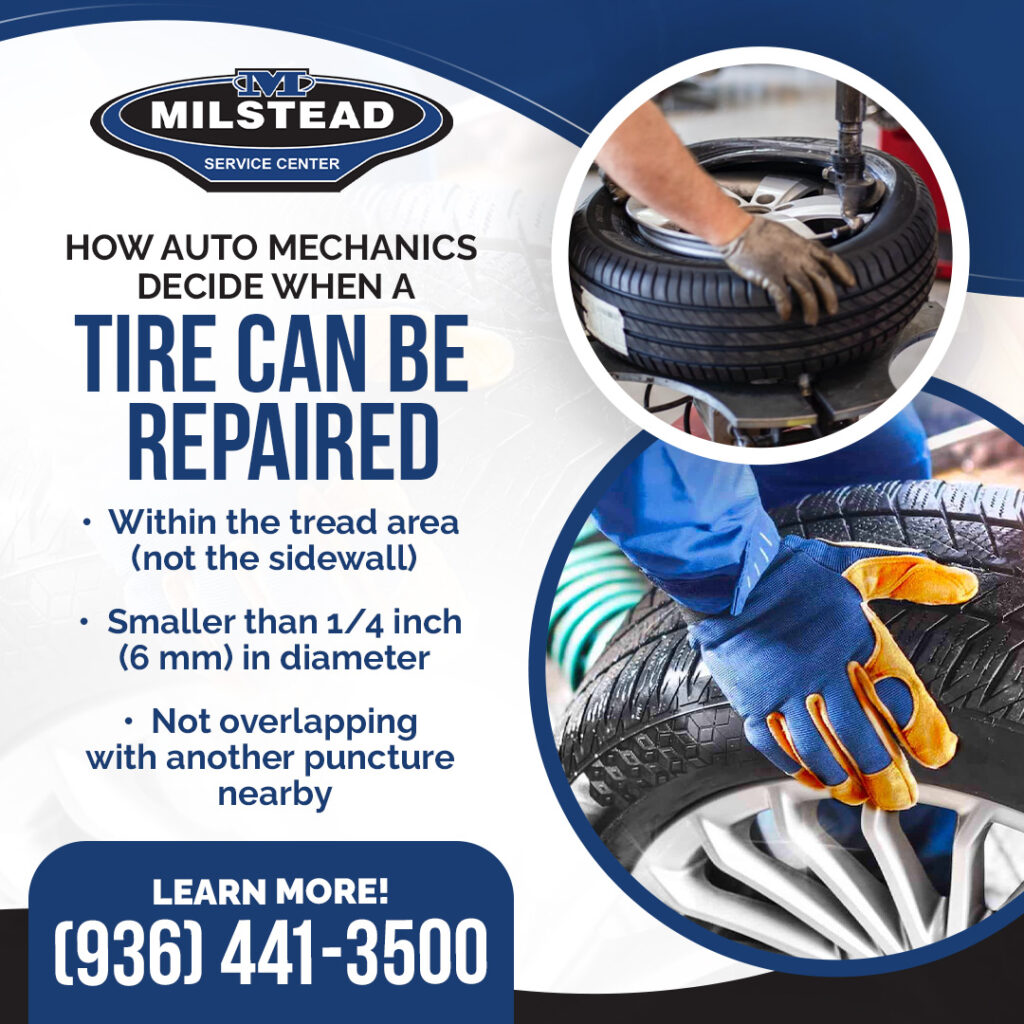
Common Causes of Tire Punctures
Tire punctures are usually caused by sharp road debris, aging rubber, or sudden impact from potholes or curbs.
Sharp Road Debris
Nails, screws, and broken glass are the most frequent causes of tire punctures. These objects pierce the tread while driving and cause slow leaks or sudden air loss. If you notice your tire losing pressure but there is no visible damage to the sidewall, embedded debris is likely the cause. An experienced auto mechanic can safely remove the object and inspect the area for safe repair.
Tire Age and Wear
Old or worn-out tires are more likely to puncture, even from minor objects. As rubber degrades over time, it becomes brittle and loses strength. Tires start deteriorating after about six years and should be inspected regularly. While age alone doesn’t mandate replacement, manufacturers and the NHTSA recommend inspecting tires closely after this age, especially if tread or sidewall issues are present.
Once the tread depth falls below 2/32 of an inch, tires should be replaced regardless of visible damage. Regular tire inspections at a certified auto shop can detect unsafe wear before it leads to a flat or blowout.
Impact from Potholes or Curbs
Hitting potholes or curbs at speed can split the inner liner or damage the tire bead. These impacts may not always be visible, but they can cause internal separation or sidewall bulges. Sidewall damage cannot be repaired safely and usually requires a full tire replacement. Road hazards such as potholes and curbs often damage tires, wheels, or suspension. While the cost varies, many drivers face hundreds of dollars in repairs annually.
If you’ve recently hit a pothole and your tire is leaking or vibrating, have it checked by an auto mechanic near you immediately to avoid further damage to the wheel or suspension.
When Tire Repair Is Possible
A puncture must be no larger than ¼ inch (6 mm) in diameter to qualify for safe repair, per industry standards.
Puncture Location – Safe Repair Zones
“Only punctures within the crown (central tread) area—about 1 to 1.5 inches in from each shoulder, with steel belts present—can be safely repaired. This aligns with USTMA and TIA standards. This zone typically covers the middle three-quarters of the tire’s width. Damage to the shoulder or sidewall cannot be fixed. These areas flex more during driving and carry more structural stress. Repairs outside the tread zone are not approved by industry guidelines, including those from the U.S. Tire Manufacturers Association (USTMA).
If you’re not sure where the puncture occurred, visit Milstead Service Center. Our auto mechanics in Conroe, TX, can inspect the tire and let you know whether a repair is possible.
Acceptable Puncture Size and Shape
Tire punctures must be 1/4 inch (6 mm) or smaller to qualify for safe repair. Any hole larger than this risks spreading under road pressure. Straight nail or screw punctures are the easiest to fix. Irregular-shaped cuts or tears caused by sharp debris often result in weakened tire structure. These are usually not repairable. Internal damage may result from driving on a flat tire, even if the puncture seems small.
Guidelines on Multiple Punctures
A tire may be repaired in multiple spots if the punctures are spaced at least 16 inches apart. If two or more holes are too close together, the tire’s strength is compromised. Even if each puncture meets repair guidelines individually, proximity can still pose a risk. If your tire has several punctures within a short distance, replacement is often the safer option.
Milstead Service Center, your trusted local auto mechanic in Conroe, TX, can measure spacing and evaluate if repair is still an option.
Proper Repair Techniques Used by Professionals
A proper tire repair involves removing the tire, inspecting it internally, and using a combination plug-patch method. Professional repairs follow USTMA standards. This means the puncture is filled with a rubber stem and sealed with a patch inside the tire. Plug-only repairs or patch-only methods are not considered reliable and can fail over time.
Always ask if your repair meets these standards. Certified technicians at our auto shop in Conroe, TX, follow the correct procedures to restore tire safety and air retention.
When Tire Replacement Is the Safer Option
A tire must be replaced if the damage affects the sidewall, is too large, or compromises the internal structure.
Damage to Sidewall or Shoulder
Punctures in the sidewall or shoulder area cannot be safely repaired. These parts of the tire experience high flex during turns and braking. Even a small cut in these zones can lead to a blowout. Unlike the tread area, the sidewall lacks the thicker rubber layers needed to support a repair.
Punctures Larger Than ¼ Inch
If a puncture is wider than 1/4 inch (6 mm), the tire should be replaced. Larger holes weaken the tire’s ability to hold air and withstand road stress. No safe repair method exists for oversized damage. Attempting to plug or patch a larger puncture increases the risk of failure, especially at highway speeds. Auto mechanics can measure the puncture and explain your safest option based on industry safety guidelines.
Structural Damage or Belt Separation
Any tire showing signs of internal damage must be replaced. This includes exposed cords, visible belt separation, or bulges on the sidewall. Structural issues occur after hitting a pothole or driving while the tire is underinflated. Even if the tire looks fine from the outside, damage inside the casing can make it unsafe.
Previously Repaired or Improperly Repaired Tires
Tires should be replaced if they have been repaired incorrectly or if the same area has been patched more than once. Overlapping repairs weaken the tire’s structure and reduce its safety. Plug-only repairs, common in DIY kits, often fail over time. They don’t seal the tire from the inside, which allows air and moisture to reach the inner steel belts.
Milstead Service Center provides professional inspections to identify tire damage that may not be visible at a glance. Our auto mechanics in Conroe, TX, follow U.S. Tire Manufacturers Association guidelines to recommend safe and reliable replacements when needed.
Dangers of Driving on a Compromised Tire
Driving on a damaged or improperly repaired tire can result in loss of control, higher fuel costs, and increased wear on vehicle parts.
Effects on Tire Structure and Vehicle Safety
A compromised tire can fail without warning, especially at high speeds. Weakened internal belts and sidewalls can increase the risk of a blowout. According to NHTSA and NTSB data, there are about 11,000 tire‑related crashes each year, resulting in approximately 6,400 injuries and 200 fatalities.
Risks to Wheels and Suspension
Driving on a deflated or damaged tire can bend the wheel and strain the suspension. As the tire loses pressure or goes flat, the metal rim may contact the road. This contact often leads to warped wheels, broken struts, or damaged control arms. These repairs are more expensive than replacing a tire. A professional inspection can prevent further damage by catching these problems early.
Impact on Fuel Economy and Ride Quality
Compromised tires increase rolling resistance, leading to poor fuel mileage and a rougher ride. Uneven wear or low pressure forces the engine to work harder. According to the U.S. Department of Energy, gas mileage may be reduced by up to 33% due to under‑inflated tires. That adds up quickly over months of driving. A trusted auto mechanic can catch these issues early and help improve both fuel economy and ride comfort.
Visit Milstead Service Center if your car feels off or the ride’s bumpier than usual. Our experienced team of auto mechanics in Conroe, TX, can check your tires, spot early signs of damage, and recommend the right fix to keep your vehicle running smoothly.
Tire Services in Conroe, TX, Offered by Milstead Service Center
Milstead Service Center provides full-service tire support, including repair, replacement, and diagnostics for all vehicle types.
Flat Tire Repair
We inspect the tire thoroughly and repair damage within approved zones using industry-standard methods. This includes patching and plugging punctures up to ¼ inch located in the tread area. Our trained auto mechanics use equipment that seals the tire from the inside, restoring safe use without compromising performance. This service is available for cars, trucks, and RVs.
Tire Replacement
When repair is not safe, we offer tire replacement using trusted brands and proper fitment. If the puncture is too large, located in the sidewall, or the tire shows signs of wear or prior improper repairs, we recommend replacing the tire. We stock a wide range of tires for various vehicles, and our auto shop in Conroe, TX, will mount and balance them for long-term reliability.
Wheel Alignment and Balancing
We offer wheel alignment and tire balancing to prevent uneven wear and improve handling. Wheel alignment corrects angles that affect how tires contact the road. Poor alignment causes pulling and vibration, which shortens tire life. Balancing reduces shaking and improves ride comfort. We use digital machines at our auto shop in Conroe, TX, for precise adjustment, available for both individual tires and complete sets.
TPMS Diagnostics and Resets
We diagnose and reset Tire Pressure Monitoring Systems (TPMS) to keep your warning system accurate. When the tire pressure drops below a safe level, TPMS sensors alert you. Faulty sensors can give false readings or fail to notify you at all. Our auto mechanics in Conroe, TX, check sensor functions, replace damaged units, and reset the system to ensure reliable operation after a repair or tire change.
How to Reduce the Risk of Future Tire Damage
Routine maintenance and safe driving habits can lower the chances of tire punctures or structural issues.
Proper Tire Inflation and Pressure Monitoring
Correct tire pressure distributes weight evenly and reduces stress on the tread. Underinflated tires run hotter and wear faster. Overinflated tires are more likely to suffer blowouts when hitting debris. Check pressure at least once a month and before long trips.
Use a reliable gauge or ask an auto mechanic to check it during service. Tire Pressure Monitoring Systems (TPMS) can also detect pressure changes early. Make sure the system is working properly, and sensors are replaced as needed.
Regular Rotation and Alignment
Rotating tires and checking alignment prevent uneven wear and extend tire life. Tires should be rotated every 5,000 to 7,000 miles. This spreads wear across all four tires, especially on vehicles with front-wheel or all-wheel drive.
Improper wheel alignment causes rapid edge wear and makes tires more prone to punctures and steering issues. Schedule alignment checks after suspension repairs or if you notice pulling or uneven wear.
Visual Checks for Embedded Debris or Damage
Inspect your tires for nails, glass, cuts, or bubbles. Sharp debris can stay lodged in the tread before causing a full puncture. Catching it early gives you a chance to repair the tire before it becomes unsafe. Look for sidewall cracks or bulges, which may indicate internal damage. If you’re unsure, have a technician take a closer look.
Best Driving Habits to Avoid Road Hazards
Avoid potholes, slow down near construction zones, and stay clear of curbs when parking. Potholes can cause sidewall damage or bent rims. Curbs often scuff sidewalls or lead to slow leaks. Use caution when driving through areas with broken pavement or road debris.
Drive at moderate speeds, especially after rain, when sharp objects may be hidden in puddles. Careful driving lowers the risk of tire failure and helps protect your suspension and wheels.
Keep Your Vehicle Safe with Proper Tire Service in Conroe, TX
Knowing when to repair or replace a punctured tire helps maintain vehicle safety and performance. A small puncture in the tread area can be repaired if caught early. However, damage to the sidewall, large punctures, or repeated repairs usually require full replacement to avoid safety risks.
If you’re unsure, it’s best to have the tire inspected by an experienced auto mechanic. At Milstead Service Center, our team follows industry-standard repair guidelines and offers full tire services, from flat repairs to replacements and TPMS diagnostics. Taking the time to address tire damage properly protects your vehicle, lowers long-term costs, and keeps you safer on the road.
Trust the certified team at Milstead Service Center for accurate tire inspections, reliable repairs, and full replacements. Call us today at (936) 441-3500 to schedule your service, or stop by our auto shop in Conroe, TX. We’re here to help you drive safely.

